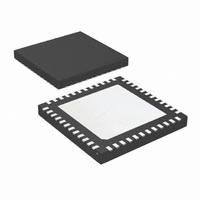DS32EL0124SQ/NOPB National Semiconductor, DS32EL0124SQ/NOPB Datasheet - Page 17

DS32EL0124SQ/NOPB
Manufacturer Part Number
DS32EL0124SQ/NOPB
Description
IC DESERIAL W/DDR LVDS 48LLP
Manufacturer
National Semiconductor
Datasheet
1.DS32EL0124SQENOPB.pdf
(28 pages)
Specifications of DS32EL0124SQ/NOPB
Function
Deserializer
Data Rate
3.125Gbps
Input Type
LVDS
Output Type
LVDS
Number Of Inputs
5
Number Of Outputs
1
Voltage - Supply
2.5V, 3.3V
Operating Temperature
-40°C ~ 85°C
Mounting Type
Surface Mount
Package / Case
48-LLP
Lead Free Status / RoHS Status
Lead free / RoHS Compliant
Other names
DS32EL0124SQ
Applications Information
GPIO PINS
The GPIO pins can be useful tools when debugging or eval-
uating the system. For specific GPIO configurations and func-
tions refer to registers 2, 3, 4, 5 and 6 in the device register
map.
GPIO pins are commonly used when there are multiple de-
serializers on the same SMBus. In order to program individual
settings into each serializer, they will each need to have a
unique SMBus address. To reprogram multiple deserializers
on a single SMBus, configure the first deserializer such that
the SMBus lines are connected to the FPGA or host controller.
The CS pin of the second serializer should be tied to GPIO0
of the first deserializer, with the CS pin of the next deseriazlier
tied to GPIO0 of its preceding deserializer. By holding all of
the GPIO0 pins low, the first deserializer’s address may now
be reprogrammed by writing to register 0. The first
deserializer’s GPIO pin can now be asserted and the second
deserializer’s address may now be reprogrammed.
HIGH SPEED COMMUNICATION MEDIA
Using the deserializer’s integrated equalizer blocks in combi-
nation with the DS32EL0421 or DS32ELX0421’s integrated
de-emphasis block allows data to be transmitted across a va-
riety of media at high speeds. Factors that can limit device
performance include excessive input clock jitter, noisy power
rails, EMI from nearby noisy components and poor layout
techniques. Although many cables contain wires of similar
gauge and shielding, performance can vary greatly depend-
ing on the quality of the connector.
The DS32ELX0124 also has a programmable de-emphasis
block on its retimed loop through output TxOUT+/-. The de-
emphasis setting for the loop through driver is programmed
through the SMBus.
REDUNDANCY APPLICATIONS
The DS32ELX0124 has two high speed CML serial inputs.
SMBus register control allows the host device to monitor for
errors or link loss on the active input channel. This enables
the host device, usually an FPGA, to switch to the secondary
input if problems occur with the primary input.
LINK AGGREGATION
Multiple
D32EL0124/DS32ELX0124 deserializers can be aggregated
together if an application requires a data throughput of more
than 3.125 Gbps. By utilizing the data valid signal of each
DS32EL0421/DS32ELX0421
serializers
and
17
device, the system can be properly deskewed to allow for a
single cable, such as CAT-6, DVI-D, or HDMI, to carry data
payloads beyond 3.125 Gbps.
Link aggregation configurations can also be implemented in
applications which require longer cable lengths. In these type
of applications the data rate of each serializer and deserializer
chipset can be reduced, such that the applications' net data
throughput is still the same. Since each high speed channel
is now operating at a fraction of the original data rate, the loss
over the cable is reduced, allowing for greater lengths of cable
to be used in the system.
For more information regarding link aggregation please see
Application Note 1887, Expanding the Payload with National's
FPGA-Link DS32ELX0421 and DS32ELX0124 Serializer and
Deserializer.
REACH EXTENSION
The DS32ELX0124 deserializer contains a retimed loop
through CML serial output. The loop through driver also has
programmable de-emphasis making this device capable of
reach extension applications.
DAISY CHAINING
The loop through driver of the DS32ELX0124 deserializer can
be used to string together deserializers in a daisy chain con-
figuration. This allows a single data source such as a
DS32EL0421 serializer to communicate to multiple receiving
systems.
LAYOUT GUIDELINES
It is important to follow good layout practices for high speed
devices. The length of LVDS input traces should not exceed
40 inches. In noisy environments the LVDS traces may need
to be shorter to prevent data corruption due to EMI. Noisy
components should not be placed next to the LVDS or CML
traces. The LVDS and CML traces must have a controlled
differential impedance of 100Ω. Do not place termination re-
sistors at the CML inputs or output, the DS32EL0124 and
DS32ELX0124 have internal termination resistors. It is rec-
ommended to avoid using vias. Each pair of vias creates an
impedance mismatch in the transmission line and result in
reflections, which can greatly lower the maximum distance of
the high speed data link. If vias are required, they should be
placed symmetrically on each side of the differential pair. For
more tips and detailed suggestions regarding high speed
board layout principles, please consult the LVDS Owner’s
Manual.
www.national.com










